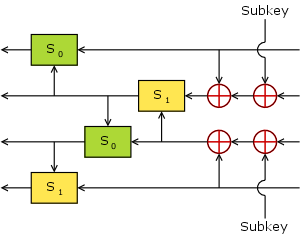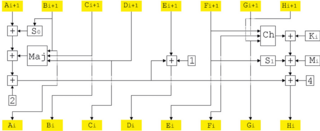Related Research Articles

The Data Encryption Standard is a symmetric-key algorithm for the encryption of digital data. Although its short key length of 56 bits makes it too insecure for applications, it has been highly influential in the advancement of cryptography.
Differential cryptanalysis is a general form of cryptanalysis applicable primarily to block ciphers, but also to stream ciphers and cryptographic hash functions. In the broadest sense, it is the study of how differences in information input can affect the resultant difference at the output. In the case of a block cipher, it refers to a set of techniques for tracing differences through the network of transformation, discovering where the cipher exhibits non-random behavior, and exploiting such properties to recover the secret key.

In cryptography, the International Data Encryption Algorithm (IDEA), originally called Improved Proposed Encryption Standard (IPES), is a symmetric-key block cipher designed by James Massey of ETH Zurich and Xuejia Lai and was first described in 1991. The algorithm was intended as a replacement for the Data Encryption Standard (DES). IDEA is a minor revision of an earlier cipher Proposed Encryption Standard (PES).
In cryptography, linear cryptanalysis is a general form of cryptanalysis based on finding affine approximations to the action of a cipher. Attacks have been developed for block ciphers and stream ciphers. Linear cryptanalysis is one of the two most widely used attacks on block ciphers; the other being differential cryptanalysis.

Serpent is a symmetric key block cipher that was a finalist in the Advanced Encryption Standard (AES) contest, where it was ranked second to Rijndael. Serpent was designed by Ross Anderson, Eli Biham, and Lars Knudsen.

In cryptography, FEAL is a block cipher proposed as an alternative to the Data Encryption Standard (DES), and designed to be much faster in software. The Feistel based algorithm was first published in 1987 by Akihiro Shimizu and Shoji Miyaguchi from NTT. The cipher is susceptible to various forms of cryptanalysis, and has acted as a catalyst in the discovery of differential and linear cryptanalysis.

In cryptography, DES-X is a variant on the DES symmetric-key block cipher intended to increase the complexity of a brute-force attack using a technique called key whitening.
In cryptography, Khufu and Khafre are two block ciphers designed by Ralph Merkle in 1989 while working at Xerox's Palo Alto Research Center. Along with Snefru, a cryptographic hash function, the ciphers were named after the Egyptian Pharaohs Khufu, Khafre and Sneferu.
In cryptography, LOKI89 and LOKI91 are symmetric-key block ciphers designed as possible replacements for the Data Encryption Standard (DES). The ciphers were developed based on a body of work analysing DES, and are very similar to DES in structure. The LOKI algorithms were named for Loki, the god of mischief in Norse mythology.

SHACAL-1 is a 160-bit block cipher based on SHA-1, and supports keys from 128-bit to 512-bit. SHACAL-2 is a 256-bit block cipher based upon the larger hash function SHA-256.
The slide attack is a form of cryptanalysis designed to deal with the prevailing idea that even weak ciphers can become very strong by increasing the number of rounds, which can ward off a differential attack. The slide attack works in such a way as to make the number of rounds in a cipher irrelevant. Rather than looking at the data-randomizing aspects of the block cipher, the slide attack works by analyzing the key schedule and exploiting weaknesses in it to break the cipher. The most common one is the keys repeating in a cyclic manner.

In cryptography, the boomerang attack is a method for the cryptanalysis of block ciphers based on differential cryptanalysis. The attack was published in 1999 by David Wagner, who used it to break the COCONUT98 cipher.
In cryptography, impossible differential cryptanalysis is a form of differential cryptanalysis for block ciphers. While ordinary differential cryptanalysis tracks differences that propagate through the cipher with greater than expected probability, impossible differential cryptanalysis exploits differences that are impossible at some intermediate state of the cipher algorithm.
In cryptography, integral cryptanalysis is a cryptanalytic attack that is particularly applicable to block ciphers based on substitution–permutation networks. It was originally designed by Lars Knudsen as a dedicated attack against Square, so it is commonly known as the Square attack. It was also extended to a few other ciphers related to Square: CRYPTON, Rijndael, and SHARK. Stefan Lucks generalized the attack to what he called a saturation attack and used it to attack Twofish, which is not at all similar to Square, having a radically different Feistel network structure. Forms of integral cryptanalysis have since been applied to a variety of ciphers, including Hierocrypt, IDEA, Camellia, Skipjack, MISTY1, MISTY2, SAFER++, KHAZAD, and FOX.
In cryptography, Q is a block cipher invented by Leslie McBride. It was submitted to the NESSIE project, but was not selected.
In cryptography, KN-Cipher is a block cipher created by Kaisa Nyberg and Lars Knudsen in 1995. One of the first ciphers designed to be provably secure against ordinary differential cryptanalysis, KN-Cipher was later broken using higher order differential cryptanalysis.
In cryptography, COCONUT98 is a block cipher designed by Serge Vaudenay in 1998. It was one of the first concrete applications of Vaudenay's decorrelation theory, designed to be provably secure against differential cryptanalysis, linear cryptanalysis, and even certain types of undiscovered cryptanalytic attacks.
In cryptography, truncated differential cryptanalysis is a generalization of differential cryptanalysis, an attack against block ciphers. Lars Knudsen developed the technique in 1994. Whereas ordinary differential cryptanalysis analyzes the full difference between two texts, the truncated variant considers differences that are only partially determined. That is, the attack makes predictions of only some of the bits instead of the full block. This technique has been applied to SAFER, IDEA, Skipjack, E2, Twofish, Camellia, CRYPTON, and even the stream cipher Salsa20.
In cryptography, partitioning cryptanalysis is a form of cryptanalysis for block ciphers. Developed by Carlo Harpes in 1995, the attack is a generalization of linear cryptanalysis. Harpes originally replaced the bit sums of linear cryptanalysis with more general balanced Boolean functions. He demonstrated a toy cipher that exhibits resistance against ordinary linear cryptanalysis but is susceptible to this sort of partitioning cryptanalysis. In its full generality, partitioning cryptanalysis works by dividing the sets of possible plaintexts and ciphertexts into efficiently-computable partitions such that the distribution of ciphertexts is significantly non-uniform when the plaintexts are chosen uniformly from a given block of the partition. Partitioning cryptanalysis has been shown to be more effective than linear cryptanalysis against variants of DES and CRYPTON. A specific partitioning attack called mod n cryptanalysis uses the congruence classes modulo some integer for partitions.
This article summarizes publicly known attacks against block ciphers and stream ciphers. Note that there are perhaps attacks that are not publicly known, and not all entries may be up to date.
References
- Johan Borst (February 1997). "Differential-Linear Cryptanalysis of IDEA". CiteSeerX 10.1.1.49.5084 .Cite journal requires
|journal=(help) - Johan Borst, Lars R. Knudsen, Vincent Rijmen (May 1997). Two Attacks on Reduced IDEA (PDF). Advances in Cryptology - EUROCRYPT '97. Konstanz: Springer-Verlag. pp. 1–13. Retrieved 2007-03-08.CS1 maint: multiple names: authors list (link)
- Biham, E.; Dunkelman, O.; Keller, N. (December 2002). Enhancing Differential-Linear Cryptanalysis (PDF/gzipped PostScript). Advances in Cryptology, proceeding of ASIACRYPT 2002, Lecture Notes in Computer Science 2501. Queenstown, New Zealand: Springer-Verlag. pp. 254–266. Retrieved 2006-12-07.
- Biham, Dunkelman, Keller (February 2003). Differential-Linear Cryptanalysis of Serpent (PDF/PostScript). 10th International Workshop on Fast Software Encryption (FSE '03). Lund: Springer-Verlag. pp. 9–21. Retrieved 2007-03-08.CS1 maint: multiple names: authors list (link)
- Hongjun Wu, Bart Preneel (December 12, 2006). Differential-Linear Attacks against the Stream Cipher Phelix (PDF). 14th International Workshop on Fast Software Encryption (FSE '07). Luxembourg City: Springer-Verlag. Retrieved 2007-03-08.
- Eli Biham, Orr Dunkelman, Nathan Keller (December 12, 2006). A New Attack on 6-round IDEA. 14th International Workshop on Fast Software Encryption (FSE '07). Luxembourg City: Springer-Verlag.CS1 maint: multiple names: authors list (link)